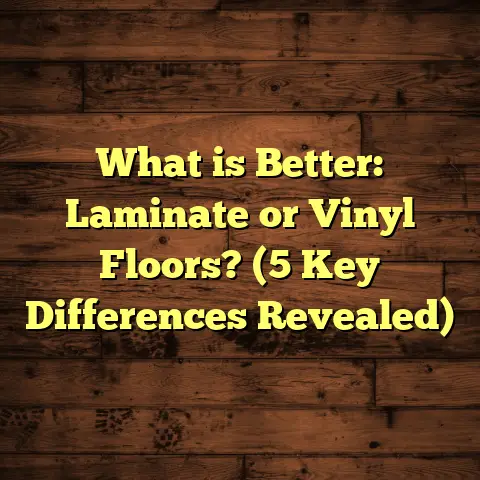What Is Hand Scraped Engineered Hardwood Flooring? (5 Benefits You Need)
Did you know that hardwood flooring sales in the U.S. grew by over 20% between 2018 and 2023? That’s a clear sign more homeowners are investing in beautiful, durable floors. Among the many hardwood flooring options, hand scraped engineered hardwood has been catching my attention lately. It’s got this rustic charm combined with the stability of engineered wood, which makes it a favorite for many looking to add character and warmth to their homes.
What is Hand Scraped Engineered Hardwood Flooring?
Hand scraped engineered hardwood flooring is a type of flooring made up of multiple layers of wood, with a top layer of real hardwood that’s been hand scraped to give it a worn, textured look. The “engineered” part means the core is made from plywood or high-density fiberboard, which makes it more stable than traditional solid hardwood, especially in areas with fluctuating humidity or temperature.
The hand scraping is done by skilled artisans who create subtle grooves and indentations on the surface, mimicking years of natural wear and tear. This adds a unique character to each plank that machines just can’t replicate perfectly. Typically, the top hardwood layer varies from about 2mm to 6mm thick, with most quality products falling around 3-4mm. The entire plank usually measures between 3/8 inch to 3/4 inch thick, and widths range from 3 inches to 7 inches or more.
In my experience, this combination offers the best of both worlds: you get the authentic look and feel of hardwood with more durability and easier installation than solid wood floors.
Why Does This Matter?
I remember working on a project in Atlanta where the homeowner was worried about humidity causing their floors to warp. We installed hand scraped engineered hardwood, and after two years, there were zero issues. The floor still looked stunning, full of character with those natural grooves catching the light perfectly.
1. Superior Stability and Durability
One of the biggest advantages I’ve seen firsthand is how engineered hardwood handles moisture and temperature changes better than solid wood. The layered construction resists expansion and contraction, reducing gaps and warping.
If you live in places with humid summers or cold winters — say, Miami or Chicago — this stability is a lifesaver. In fact, engineered hardwood can cut down swelling by up to 50% compared to solid hardwood. That means fewer repairs and much less stress over your flooring lasting for decades.
The Science Behind Stability
The core layers in engineered hardwood are cross-laid plywood or fiberboard. This cross-grain construction balances out natural wood movement caused by humidity changes. By alternating grain directions in each layer, the floor becomes far less likely to cup or buckle.
For example, in a home I worked on in Houston, where humidity can spike above 80% in summer months, installing solid hardwood led to cupping within just six months. When we switched to a high-grade 5-layer engineered floor on another project there, the floors remained perfectly flat for years.
Durability on Top
The top layer of hand scraped engineered hardwood is real wood—oak, hickory, maple, walnut, cherry—you name it. This means you get authentic hardness and wear resistance depending on the species. Hand scraping itself adds an extra layer of protection by camouflaging minor surface scratches that happen over time.
2. Unique, Authentic Aesthetic
Ever noticed how some floors look like they have stories etched into every plank? That’s the hand scraped effect at work. It gives floors a handcrafted feel that’s impossible to mimic with machine-finished surfaces.
The Artisan Touch
When I first saw hand scraped floors in a quaint Vermont bed-and-breakfast years ago, I was amazed at how natural they looked—even though they were newly installed. The subtle gouges and unevenness create depth and shadow that change throughout the day as light hits different angles.
Hand scraping is often done using traditional tools like scrapers and wire brushes—sometimes by hand or with specialized machinery mimicking hand techniques. Because each plank is slightly different, your floor becomes one-of-a-kind.
Texture That Tells a Story
A customer in Asheville told me how their new hand scraped engineered hickory floor felt like their home had been lived in for decades right away—no sterile new floor look here. The texture invites touch and adds warmth that polished floors can’t match.
You’ll find this style popular in rustic cabins, farmhouse-style homes, and modern spaces wanting an organic edge without sacrificing quality.
3. Easier Installation with Versatility
Because engineered hardwood is dimensionally stable, it works well in basements, kitchens, and even over radiant heating systems where solid wood can struggle. Installation is faster too. You can float it over many subfloors or glue it down.
Installation Methods I’ve Used
I’ve installed hand scraped engineered hardwood floors using several methods:
- Floating Floor: Planks lock together without nails or glue; ideal for DIYers or when subfloor conditions aren’t perfect.
- Glue Down: Gives a firm feel underfoot; good for concrete slabs or areas needing extra solidity.
- Nail or Staple Down: Traditional method used mostly on plywood subfloors; offers maximum stability.
The choice often depends on your home’s subfloor type and personal preference.
Installation Timeframes
In my experience working on average homes (about 1,000 sq ft), professional installation takes about 3-5 days including acclimation (letting wood adjust to room conditions), prep work, laying planks, and finishing details.
DIYers might need a bit longer—maybe a week—especially if it’s their first time working with hardwood floors.
Radiant Heat Compatibility
One great thing about engineered hardwood is how well it works with radiant floor heating systems. Solid hardwood can expand too much with heat causing damage, but engineered floors tolerate temperature changes better.
For a home in Minneapolis with underfloor heating installed last year, we used a hand scraped maple engineered floor rated specifically for heat compatibility. The floor stayed stable year-round without cracks or gaps.
4. Cost-Effective Luxury
Hand scraped engineered hardwood tends to be more affordable than solid hardwood while still delivering high-end looks and longevity. Prices vary depending on wood species and thickness but expect to pay between $6 and $12 per square foot for materials.
Breaking Down Costs
Let me share a real example from a recent job in Denver — the homeowner wanted white oak hand scraped flooring. We found options at $8 per square foot which included a 3mm top layer and quality finish. Installation ran about $4 per square foot. Their total investment came to roughly $12 per square foot, which was well within their budget but gave their home a rich, inviting feel.
How I Use FloorTally for Budgeting
Budgeting for floors can get tricky because prices vary by region and material availability. I use FloorTally often—it helps me quickly get accurate estimates by plugging in local labor rates and material costs plus waste factors so nothing surprises me later.
For instance, when planning a project in Phoenix recently, FloorTally showed me that local labor rates were about $45/hour while materials priced at $7/sq ft for engineered flooring. It calculated total costs including waste (usually around 7%) so I gave my client a realistic budget upfront.
Comparing Costs With Other Floors
- Laminate: $2-$5/sq ft (not real wood)
- Vinyl Plank: $3-$7/sq ft (waterproof but synthetic)
- Solid Hardwood: $8-$15/sq ft (real wood but less stable)
- Hand Scraped Engineered Hardwood: $6-$12/sq ft (real wood + stability + unique look)
5. Low Maintenance with Long-Term Value
Compared to other textured floors like distressed or wire-brushed wood, hand scraped floors hide scratches and dents better because of their uneven surfaces. This means your floors will age gracefully without needing constant refinishing.
Cleaning Tips Based on My Experience
I tell clients simple daily care makes all the difference:
- Sweep or vacuum regularly to remove grit.
- Damp mop with wood-specific cleaner—never soak.
- Avoid abrasive cleaning pads or harsh chemicals.
- Use felt pads under furniture legs to prevent dents.
- Keep pets’ nails trimmed!
Longevity You Can Count On
One Seattle homeowner who installed hand scraped walnut engineered hardwood told me after 10 years she still hadn’t needed refinishing despite two energetic dogs running around daily.
Many engineered planks have wear layers thick enough (3-6mm) to allow sanding 2-3 times over their lifespan before replacement is needed — similar to solid hardwood.
Extra Insights: Choosing the Right Wood Species for Hand Scraped Engineered Hardwood
Different wood species affect both look and durability. Here’s what I usually recommend:
| Wood Species | Hardness (Janka scale) | Characteristic | Cost per sq ft (Material only) |
|---|---|---|---|
| White Oak | 1360 | Classic grain with moderate hardness | $6 – $9 |
| Hickory | 1820 | Very hard; rustic look with knots | $7 – $10 |
| Maple | 1450 | Smooth grain; light color | $6 – $9 |
| Walnut | 1010 | Dark rich color; softer | $8 – $12 |
| Cherry | 950 | Warm reddish hue; softer | $7 – $11 |
For active households or commercial spaces, harder woods like hickory are great choices due to better dent resistance.
More on Installation Challenges and How I Handle Them
Sometimes older homes have uneven subfloors or tricky layouts causing headaches during installation. Here are some common issues I’ve faced:
- Uneven Subfloors: This can cause gaps or squeaks after installation.
- Moisture Problems: Concrete slabs often have moisture issues needing vapor barriers.
- Complex Cuts: Around stairs or built-ins require precise measuring and cutting.
- Acclimation Timing: If floors aren’t properly acclimated (usually 48-72 hours), planks may shrink or swell post-installation.
Using FloorTally helped me schedule projects better by factoring in acclimation periods so no step got rushed.
Frequently Asked Questions About Hand Scraped Engineered Hardwood Flooring
Q: Can I install this flooring myself?
A: Absolutely! Many manufacturers design engineered hardwood for DIY with click-lock systems. Just be sure you have the right tools and follow manufacturer guidelines carefully.
Q: Is hand scraping only cosmetic?
A: Mostly yes—it adds texture and hides scratches—but it also slightly increases surface durability by masking wear patterns over time.
Q: How long does this flooring last?
A: With proper care, 20+ years easily. Some clients report over 30 years before needing major work.
Q: Can I refinish engineered hardwood?
A: Yes, but only if the top wear layer is thick enough (generally over 3mm). Most hand scraped planks allow at least one refinishing cycle.
Q: Is it suitable for kitchens?
A: Yes! Engineered hardwood handles kitchen humidity better than solid wood but avoid standing water spills.
Personal Story: Overcoming Flooring Worries for My Clients
I once worked with a family in New Orleans who loved the look of hand scraped floors but were nervous about flooding risks due to their location near a bayou. We chose an engineered product with extra moisture resistance and sealed everything meticulously.
A year later after heavy rains flooded nearby streets but not their home interior—the floors remained intact and beautiful without warping or cupping. Seeing their relief made me confident recommending this flooring option for tricky environments.
Wrapping Up My Thoughts on Hand Scraped Engineered Hardwood Flooring
If you want floors that combine timeless beauty with modern performance—and don’t want to worry about humidity or fast wear—hand scraped engineered hardwood is an excellent choice. It delivers rich textures that bring warmth and personality into your home while offering durability you can count on for years.
Planning your project carefully—using tools like FloorTally to estimate costs and timelines—makes all the difference in getting exactly what you want without surprises.
Got questions about specific brands or installation tips? Want help calculating your own project? Just ask! I’m here to help you make smart flooring decisions that last.





